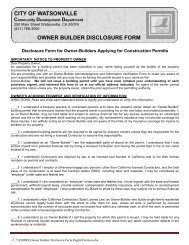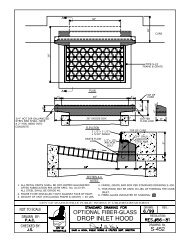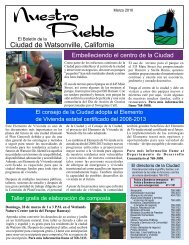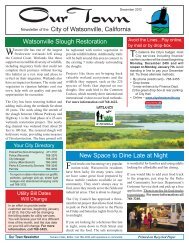Vegetation Management and Maintenance Plan - Watsonville ...
Vegetation Management and Maintenance Plan - Watsonville ...
Vegetation Management and Maintenance Plan - Watsonville ...
You also want an ePaper? Increase the reach of your titles
YUMPU automatically turns print PDFs into web optimized ePapers that Google loves.
whipping is critical. However, local conditions require site inspections to determine the exact<br />
timing. The initial weed whipping should occur soon after the thistle has bolted (the main stem<br />
has risen from the basal leaf grouping) <strong>and</strong> during the period when the flower buds are forming,<br />
but have not yet opened. As bull thistles flower later in the season than Italian <strong>and</strong> slender thistle,<br />
the initial weed whipping for bull thistle may occur at a different time. However, it is likely that<br />
the initial bull thistle treatment will correspond with a secondary treatment for the Italian <strong>and</strong><br />
slender thistle species. Additionally, for maximum effectiveness, as all thistles in an area do not<br />
bolt at the exact same time, several sessions over a period of a couple weeks may be required. If<br />
funding or labor availability is limited, the initial weed whipping should occur when the majority<br />
of thistles have bolted <strong>and</strong> are creating buds. If the timing is correct, only one or two retreatments<br />
should be necessary. A periodic inspection of the thistle sites will be required to<br />
determine the number <strong>and</strong> timing of re-treatments. Any thistle flowers that have opened or about<br />
to open should be bagged <strong>and</strong> removed from the site<br />
Bristly ox-tongue - Bristly ox-tongue should be weed-whipped prior to flower opening <strong>and</strong> seed<br />
formation, in the late spring (see Table 5). Bristly ox-tongue should be weed-whipped as close to<br />
the ground as possible without causing erosion or causing damage to desirable plant species.<br />
String heads should prove effective, except late in the season, although plastic blades provide<br />
greater control. As bristly ox-tongues flower over a long period of time, periodic site inspections<br />
should occur during the flowering cycle <strong>and</strong> multiple treatments are likely. Any flowers that have<br />
opened should be bagged <strong>and</strong> removed from the site.<br />
Poison hemlock - Weed-whipping is most efficient if it occurs after the stalk has formed <strong>and</strong><br />
before the flowers have opened. If weed whipping occurs after the flowers have opened, it should<br />
occur prior to seed formation. If poison hemlock is weed-whipped after the flowers have opened,<br />
the flower heads should be separated from the major mass of the stem <strong>and</strong> root <strong>and</strong> be bagged <strong>and</strong><br />
removed from the site.<br />
Although string heads are effective in the spring <strong>and</strong> early summer, plastic blades may be<br />
required later in the season. Repeated treatments will be required, as poison hemlock can have<br />
large root reserves. In some locations, poison hemlock can grow year-round <strong>and</strong> may require<br />
periodic site inspections, throughout the year. Multiple spring <strong>and</strong> fall mowing/weed-whipping<br />
should be done at the lowest height possible, without disturbing the soil (approximately 2-3<br />
inches, depending upon equipment).<br />
As poison hemlock is an annual/biennial species, with seed viability of three or four years, the<br />
mowing/whipping regime needs to occur intensively for 3-5 years. Weed-whipping plants that<br />
have dropped their seed is of limited usefulness for control, as the plant dies after seeding. The<br />
entire poison hemlock plant is toxic <strong>and</strong> all above ground biomass should be removed from site if<br />
animals or people may eat it.<br />
3.1.5 Solarization<br />
There are two types of solarization used to control weeds. Within the VMMM project area, only<br />
one type of solarization is applicable for weed management, due to factors such as cost <strong>and</strong><br />
human disturbance. Within the VMMM project area, solarization is a suitable treatment for<br />
Kikuyu grass, Harding/canary grass <strong>and</strong> potentially, poison hemlock (Table 4). For these species,<br />
a minimum thickness 10mm black plastic needs to be in place for one or more years to effectively<br />
kill the plant/plant roots <strong>and</strong> the successional weed seeds. Additionally, treatment by solarization<br />
may be suitable for isolated large patches of many other invasive weeds, depending on location,<br />
slope <strong>and</strong> proximity to desirable native plants. The use of City-supplied 30mil l<strong>and</strong>fill liner<br />
<strong>Vegetation</strong> <strong>Management</strong> <strong>and</strong> <strong>Maintenance</strong> Manual<br />
Draft 18 July 27, 2007
















